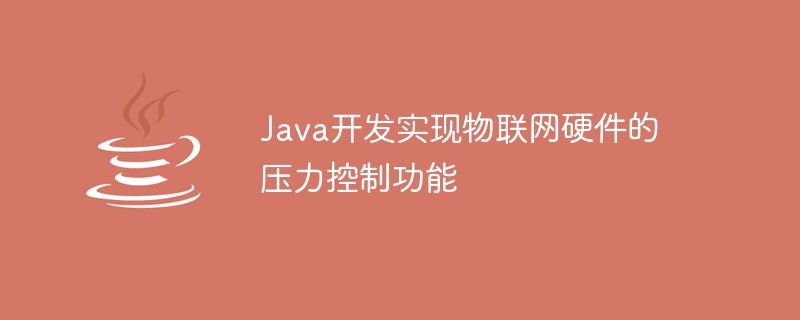

Java development implements the pressure control function of IoT hardware, requiring specific code examples
Abstract: This article introduces how to use the Java programming language to develop Internet of Things (IoT) applications Program to realize the control and monitoring functions of the pressure sensor. By using Java's hardware interface library, we can easily read sensor data and control and alarm based on set thresholds. The specific implementation code will be explained in detail in the following sections.
Keywords: Java, Internet of Things, pressure sensor, control, monitoring, hardware interface library, threshold, alarm
First, we need to initialize the GPIO interface. In Java, we can use the Pi4J library to access the GPIO interface. Create a new Java project in Eclipse, and then introduce the Pi4J library into the project. Next, we can initialize the GPIO interface through the following code:
import com.pi4j.io.gpio.*; public class PressureControl { public static void main(String[] args) { // 创建一个GPIO实例 final GpioController gpio = GpioFactory.getInstance(); // 创建一个GPIO脚位 final GpioPinDigitalInput pin = gpio.provisionDigitalInputPin(RaspiPin.GPIO_01, PinPullResistance.PULL_DOWN); // 设置脚位监听器 pin.addListener(new GpioPinListenerDigital() { @Override public void handleGpioPinDigitalStateChangeEvent(GpioPinDigitalStateChangeEvent event) { // 通过GPIO接口读取压力传感器的数值 int pressure = pin.getState().getValue(); // 对读取到的数值进行控制和报警 if (pressure > 100) { System.out.println("压力过高,进行报警!"); } } }); } }
In the above code, we first create a GPIO instance, then create a GPIO pin and set it as a digital input type. Next, we added a pin listener. When the pin status changes, itshandleGpioPinDigitalStateChangeEventmethod will be called. In this method, we read the value of the pressure sensor and perform corresponding control and alarm operations.
References:
[1] Pi4J - Java I/O library for Raspberry Pi. [Online access] https://pi4j.com/
Note: Above The hardware interfaces and examples in the code are just a demonstration. In actual projects, corresponding configuration and adjustments need to be made based on the specific hardware and platform. When using hardware, be sure to follow relevant safety regulations and precautions.
The above is the detailed content of Java develops and implements the pressure control function of IoT hardware. For more information, please follow other related articles on the PHP Chinese website!
 What are the applications of the Internet of Things?
What are the applications of the Internet of Things? The m2m concept in the Internet of Things
The m2m concept in the Internet of Things High-level language programming
High-level language programming Usage of velocity annotation
Usage of velocity annotation How to open html files
How to open html files How to use spyder
How to use spyder How to make a call without showing your number
How to make a call without showing your number How to solve the problem of garbled characters when opening a web page
How to solve the problem of garbled characters when opening a web page



